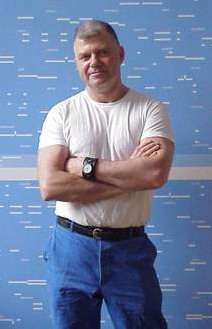Keith Milow
| Keith Milow | |
|---|---|
 | |
| Born |
29 December 1945 London |
| Nationality | English |
| Education |
Camberwell School of Art (1962–1967) Royal College of Art (1967–1982) |
| Known for | Painting, printmaking, sculpture |
| Movement | Post-minimalism |
| Awards |
Calouste Gulbenkian Foundation award (1976) Arts Council of Great Britain major award (1979) Edward Albee Foundation award (1983) |
Keith Milow is a British artist, born in London (1945), grew up in Baldock, Hertfordshire, lived in New York City (1980–2002) and Amsterdam (2002-2014), now lives in London. He is an abstract sculptor, as well as a painter and printmaker. His work can be characterized as architectural, monumental, and (post-)minimal.
Throughout his career Keith Milow has been pre-occupied with the form of the Latin cross. During the last decenium of the 20th century, Keith Milow produced a series of sculptures ('tondi') and paintings which paid tribute to the great artists of the 20th century. A major influence on his work comes from the Dutch painter Piet Mondrian. Some of his painting and drawing demonstrates a mathematical precision that almost has the appearance of being computer-generated.
Keith Milow was educated at the Knights Templar School in Baldock, the Camberwell School of Art, 1962–1967, and Royal College of Art, 1967-1968. In 1970 he received a Gregory Fellowship from Leeds University, which was followed in 1972 by a Harkness Fellowship to the USA. Awards included the Calouste Gulbenkian Foundation award (1976), the Arts Council of Great Britain major award (1979), and the Edward Albee Foundation award (1983).
During the 1970s, Milow was considered part of the British artistic avant-garde along with artists such as Richard Long, Gilbert & George, Michael Craig-Martin, Mark Lancaster, Tim Head, Nicholas Pope, John Walker, David Tremlett, Barry Flanagan, Art & Language and Derek Jarman.[1]
In 1970 Keith Milow had his first show with Nigel Greenwood Gallery, with whom he continued to show until 1992. Other galleries that held solo exhibitions of Milow's work include Duffy & Sons, New York (1973), Hester Van Royen Gallery, London (1975), Kettle's Yard Gallery, Cambridge (1976), Gallerie Albert Baronian, Brussels (1977), Park Square Gallery, Leeds (1977), Roundhouse Gallery, London (1978), Galerie Loyse Oppenheim, Geneva (1979), Annina Nosei Gallery, New York (1981, 1982), Alexander Wood Gallery, New York (1987), John Davis Gallery, New York (1988), Gallery 630B, New Orleans (1990), and Nohra Haime Gallery, New York (1990–99).
Group exhibitions included the 'Young Contemporaries' at Tate Britain (1967), 'Six at the Hayward', Hayward Gallery (1969), ' Works on Paper', Museum of Modern Art (1971), British exhibition, Art Basel (1975), 'Arte Inglese Oggi', Palazzo Reale, Milan (1976), 'British Painting 1952-1977', Royal Academy of Art (1977), 'British Art Now', Solomon R. Guggenheim Museum (1980), 'Aspects of British Art Today', Tokyo Metropolitan Museum of Art (1982), ' Modern British Sculpture', Whitechapel Gallery (1986), 'Modern British Sculpture', Tate Liverpool (1988), 'Contemporary British Artists: Mirror up to Nature', Denver Art Museum (1998), and 'United Enemies: Sculpture in 1960s and 1970s Britain', Henry Moore Institute (2011–12)
Works of Milow are included in public collections, such as Museum of Modern Art, Guggenheim Museum, Walker Art Center, Dallas Museum of Art, Denver Art Museum, Tate Galleries, Warwick Arts Centre, Henry Moore Foundation, Leeds City Art Gallery, National Gallery of Australia and Art Gallery of South Australia.
Sources and references
- Debrett's People of Today 2006, ed. Charles Mosley, London 2006 (page 1134)
- ↑ "Keith Milow (b. 1945)". Fine Art. Retrieved 2012-12-01.
External links
| Wikimedia Commons has media related to Keith Milow. |
Works
 Cross Sculpture, 2005
Cross Sculpture, 2005 Cross Drawings, 1999-2000
Cross Drawings, 1999-2000 20th Century-Thames, 1998
20th Century-Thames, 1998 After Words, 2008
After Words, 2008